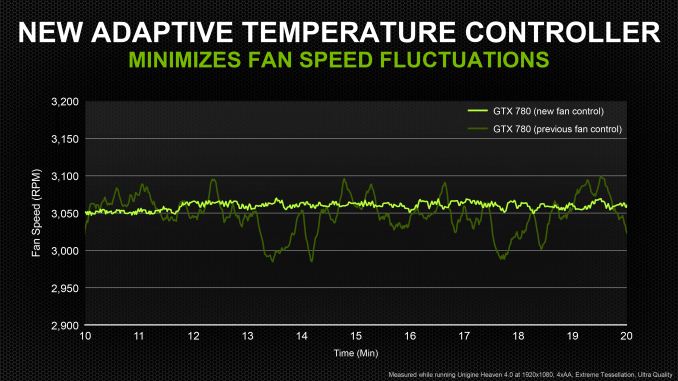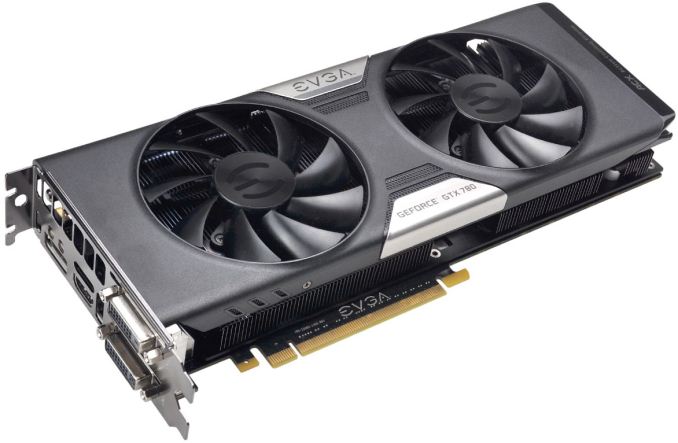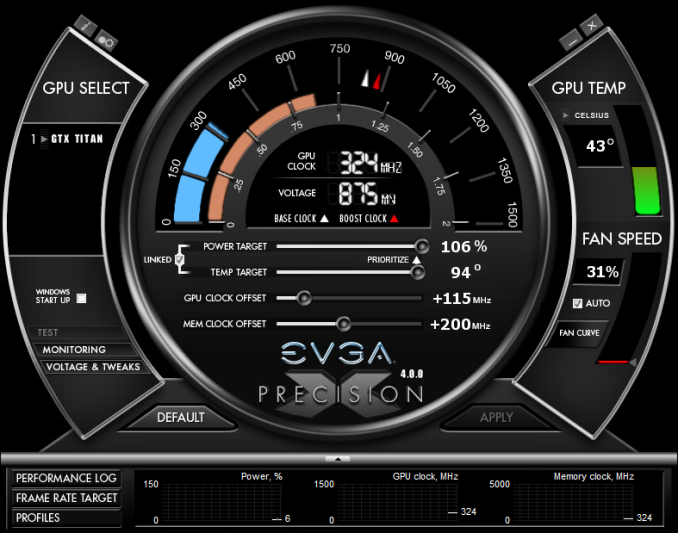NVIDIA GeForce GTX 780 Review: The New High End
by Ryan Smith on May 23, 2013 9:00 AM ESTMeet The GeForce GTX 780, Cont
With all of that said, GTX 780 does make one notable deviation from GTX Titan. NVIDIA has changed their stock fan programming for GTX 780, essentially slowing down the fan response time to even out fluctuations in fan speeds. NVIDIA has told us that they’ve found that next to loud fans in general, the second most important factor in fan noise becoming noticeable is rapidly changing fan speeds, with the changing pitch and volume drawing attention to the card. Slowing down the response time in turn will in theory keep the fan speed from spiking so much, or quickly dropping (i.e. loading screen) only to have to immediately jump back up again.
In our experience fan response times haven’t been an issue with Titan or past NVIDIA cards, and we’d be hard pressed to tell the difference between GTX 780 and Titan. With that said there’s nothing to lose from this change, GTX 780 doesn’t seem to be in any way worse for it, so in our eyes there’s no reason for NVIDIA not to go ahead with the change.
On that note, since this is purely a software(BIOS) change, we asked NVIDIA about whether this could be backported to the hardware equivalent Titan. The answer is fundamentally yes, but because NVIDIA doesn’t have a backup BIOS system, they aren’t keen on using BIOS flashing any more than necessary. So an official (or even unofficial) update from NVIDIA is unlikely, but given the user community’s adept BIOS modding skills it’s always possible a 3rd party could accomplish this on their own.
Moving on, unlike Titan and GTX 690, NVIDIA will be allowing partners to customize GTX 780, making this the first line of GK110 cards to allow customization. Potential buyers that were for whatever reason disinterested in Titan due to its blower will find that NVIDIA’s partners are already putting together more traditional open air cooler coolers for GTX 780. We can’t share any data about them yet – today is all about the reference card – but we already have one such card in-hand with EVGA’s GeForce GTX 780 ACX.
The reference GTX 780 sets a very high bar in terms of build quality and performance, so it will be interesting to see what NVIDIA’s partners can come up with. With NVIDIA testing and approving all designs under their Greenlight program, all custom cards have to meet or beat NVIDIA’s reference card in factors such as noise and power delivery, which for GTX 780 will not be an easy feat. However because of this requirement it means NVIDIA’s partners can deviate from NVIDIA’s reference design without buyers needing to be concerned that custom cards are significantly worse than then reference cards, something that benefits NVIDIA’s partners by their being able to attest to the quality of their products (“it got through Greenlight”), and benefitting buyers by letting them know they’re getting something that will be as good as the reference GTX 780, regardless of the specific make or model.
On that note, since we’re talking about card construction let’s quickly dive into overclocking. Overclocking is essentially unchanged from GTX Titan, especially since everything so far is using the reference PCB. The maximum power target remains at 106% (265W) and the maximum temperature target remains at 95C. Buyers will be able to adjust these as they please through Precision X and other tools, but no more than they already could on Titan, which means overclocking is fairly locked down.
Overvolting is also supported in a Titan-like manner, and once again is at the discretion of the card’s partner. By default GTX 780 has a maximum voltage of 1.1625v, with approved overvolting allowing the card to be pushed to 1.2v. This comes in the form of higher boost bins, so enabling overvolting is equivalent to unlocking a +13MHz bin and a +26MHz bin and their requisite voltages. However this also means that those voltages aren’t typically reached with overclocking and overvolting only has a minimal effect, as most overclocking attempts are going to hit TDP limits before they hit the unlocked boost bins.
| GeForce Clockspeed Bins | ||||
| Clockspeed | GTX Titan | GTX 780 | ||
| 1032MHz | N/A | 1.2v | ||
| 1019MHz | 1.2v | 1.175v | ||
| 1006MHz | 1.175v | 1.1625v | ||
| 992MHz | 1.1625v | 1.15v | ||
| 979MHz | 1.15v | 1.137v | ||
| 966MHz | 1.137v | 1.125v | ||
| 953MHz | 1.125v | 1.112v | ||
| 940MHz | 1.112v | 1.1v | ||
| 927MHz | 1.1v | 1.087v | ||
| 914MHz | 1.087v | 1.075v | ||













155 Comments
View All Comments
Finally - Thursday, May 23, 2013 - link
The GTX770 is a GTX680 with a different BIOS.Degong330 - Thursday, May 23, 2013 - link
Amused to see blind fanboy comments=PaulRod - Friday, May 24, 2013 - link
Well it is... slightly tweaked core, new bios, slightly improved performance... only worth buying if you're still on a 500/6000 series card or older.YukaKun - Friday, May 24, 2013 - link
Actually, it is true... At least, for the curent PCB GTX680'sCheers!
Ninjawithagun - Monday, May 27, 2013 - link
No, Finally is correct - the GTX 770 really is a GTX680 with a different BIOS! Unfortunately, there is no way to flash an existing GTX680 to a GTX770, in spite of early reports that such a capability existed. It was found out that in fact, the BIOS that was used to flash a GTX680 to a GTX770 was in fact a fake. The BIOS was a modified GTX680 BIOS made to look as if it were a GTX770 BIOS. Confused yet? lol The bottom line is that the only difference between a GTX680 and GTX770 is the clock speeds. The GTX770 comes in at around 11-12% faster clock speeds and as such is about that much faster in frame rate rendering in games. So if you already own one or more GTX680s, it is definitely NOT worth upgrading to a GTX770!An00bis - Friday, May 31, 2013 - link
this reminds me of the 7870, differences of under 10%, about 5% clock to clock compared to a 7850 that can OC the same, and people still buy it even though it's like $50 or more expensive than a 7850, just because it comes with a 1ghz OC, compared to a 7850 that only comes at about 800mhz stock.DanNeely - Thursday, May 23, 2013 - link
The 770 is using a revised version of the chip. While we're unlikely to see a large improvement it should run slightly faster for the same TDP.Hrel - Friday, May 24, 2013 - link
500Machelios - Thursday, May 23, 2013 - link
Better value than Titan, but still very niche...I'd like to see what Nvidia and AMD can bring at $250 in their next gen cards
AssBall - Thursday, May 23, 2013 - link
Agreed. A good video card should cost about as much as a good CPU, or a good MB.